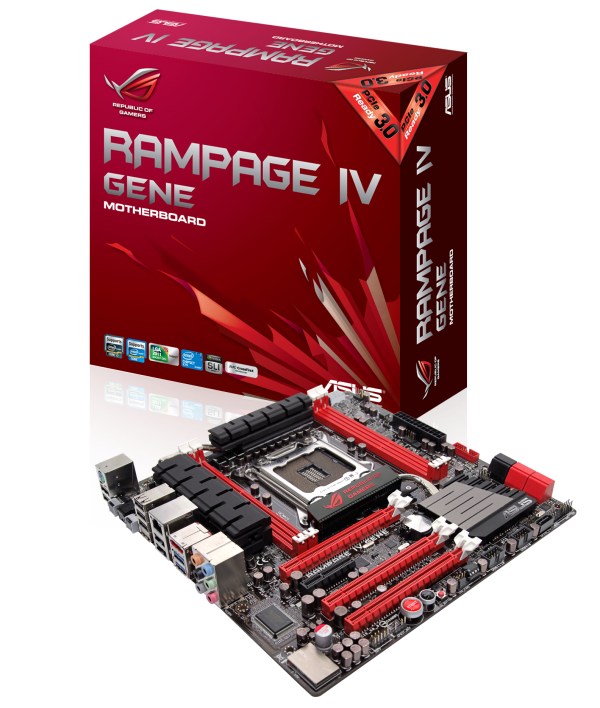ASUS Republic of Gamers and X79 ROG Review – Rampage IV Gene, Formula and Extreme
by Ian Cutress on August 3, 2012 1:00 PM EST- Posted in
- Motherboards
- Asus
- X79
- ROG
If a user wants the top end of performance, they are going to have to look towards the X79 and Sandy Bridge-E platform. If they want the best of that platform, it would not hurt to start looking at the Republic of Gamers range to see if a motherboard would suit them. In this review, we have analyzed the Rampage IV Gene, the Rampage IV Formula and the Rampage IV Extreme - the entire ASUS Republic of Gamers range for this platform, with a mélange of real-world tests and some more exotic extreme enthusiast scenarios.
The Republic of Gamers motherboards for X79 do not come in cheap. For a platform where the processor range varies from $300 to $1000, cost is rarely a talking point. However, for completeness, here is how the ROG boards currently stack up price wise (from Newegg) against the rest of the X79 range (some of which we at AnandTech have tested):
$445 - EVGA X79 Classified
$430 - ASUS Rampage IV Extreme
$390 - MSI Big Bang-XPower II
$370 - ASRock X79 Champion
$360 - ASUS Rampage IV Formula
$350 - Gigabyte G1. Assassin2
$345 - ASRock X79 Extreme9
$310 - ASUS P9X79 Pro
$310 - ECS X79R-AX Black Extreme
$300 - EVGA X79 SLI
$280 - ASUS Rampage IV Gene
$265 - Intel DX79SI
$260 - ASUS P9X79
$245 - ASRock X79 Extreme7
$240 - Gigabyte X79-UD3
$230 - Biostar TPower X79
$225 - ASRock X79 Extreme4
$214 - ASRock X79 Extreme4-M
With the Formula and Extreme both catering for the more-than-dual GPU crowd, it is unsurprising that they are more at the upper end of the price range. The Rampage IV Gene is the most expensive of the MicroATX boards, but it does put some of the full sized ATX boards above it to shame in terms of performance.
ASUS Rampage IV Gene Conclusion
High end, small(er) form factor motherboards can often be a bit of a quandary. On the one hand, a user could have a serious processor costing around $1000 with all the bells and whistles a processor should have - why would they consider pairing it with a motherboard that limits itself on size? The answer lies in usage scenarios, and ultimately performance.
The Gene is not a normal mATX board - ASUS have asked me to state explicitly that the Gene is more of a entry level ROG motherboard rather than one aimed at SFF systems. It gets the benefit of ROG development, whilst retaining a modicum of mobility and the utmost of performance.
In my view, the Gene is a great product if a user has two PCIe devices or less. In terms of new hardware over other X79 products, the ROG glaze expands to the focused SupremeFX III audio and the Intel NIC, but the selling point of the Gene will be in the ASUS branded features. ROG Connect for example will let a user manage a PC from a mobile device; the fan headers on board are typical of ASUS and better than any other manufacturers' implementation. USB BIOS Flashback helps users updating the BIOS without CPU, Memory or a VGA, and the heatsinks are buffed up to take the strain of an enthusiast system.
The main competition from the Gene comes from the boards priced around it - the Intel DX79SI for example is a full sized ATX board with dual Intel NICs or the ASUS P9X79 has a full complement of memory slots. Compared to the other mATX boards, such the cheap-as-chips ASRock X79 Extreme4-M, the Gene is similar in terms of outward facing hardware, but surpasses the 4-M for performance and feature set. This is not forgetting the Gene also come with 3-years warranty and ASUS Premium Service for North American customers.
The Gene is not to be taken lightly. Despite the extra cost over the Extreme4-M, the Gene still gets big thumbs up from the ASUS ROG garnish and performance thanks to ASUS MultiCore Enhancement. Overclocking was great too, matching the other ROG boards easily enough and beating many of the other X79 competitors for performance and ease-of-use.
The Gene is still missing a delicate spark. The extras in the box were perhaps missing a little bonus, such as a USB 3.0 panel. If I were in the design team, I would consider reshuffling the IO panel to rid the empty space, and consider stripping out the audio and placing it on an add-in card, then have the PCIe as x1, x16, x8, x16. There would perhaps be space for a built-in WiFi card (or include it in the audio card).
Nevertheless, the Gene is still a great product for an enthusiast. As a result, I would like to give the Rampage IV Gene an AnandTech Editors' Choice Bronze Award.

ASUS Rampage IV Gene
Bronze Award











34 Comments
View All Comments
DaViper - Sunday, August 5, 2012 - link
Very Good Article Ian Cutress, BUT wheres the rest of the ROG Brand like the Crosshair Boards. there really is nothing in the Article about anything AMD/ATI side of ROG. We that do have the AMD side do like to see reviews about them as well but most of the time we get left out and considering here shortly there will be a New Addition to that line although it's named for Gamers but instead it's aimed Squarely at OverClockers and has all the Gamers Perks Removed.GL1zdA - Monday, August 6, 2012 - link
I have the Rampage IV Formula board and since the version of Daemon Tools bundled with the mainboard is outdated (and you can't upgrade it to a newer version) I e-mailed the Daemon Tools team to ask about an upgrade. They offered me upgrading to Daemon Tools Advanced with lifetimes upgrades for 10 Euro - a nice deal considered the full version would cost me 35 Euro.I also mailed the cfos team to ask about upgrading the outdated GameFirst software to regular cfosSpeed (I was using cfosSpeed for years on my other PC), but they never mailed back.
pandemonium - Monday, August 6, 2012 - link
That was a very inclusive article. Thank you!I am curious to see if newer drivers would improve 3x/4x scaling, though, for the games tested I don't remember any noted improvements from AMD's Catalyst changelogs...
dj christian - Wednesday, August 8, 2012 - link
Is this article bought by ASUS? I see no reason for the reviewer to do the same for other motherboard companies even including Intel.